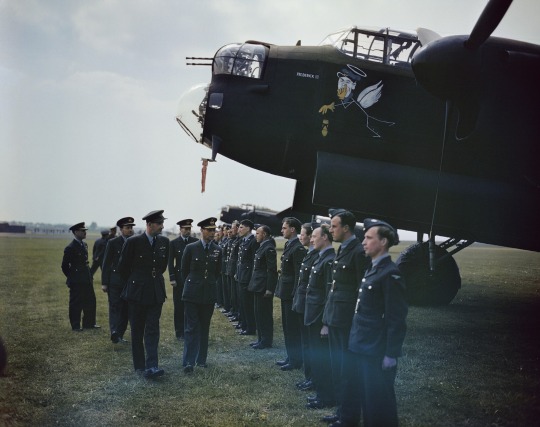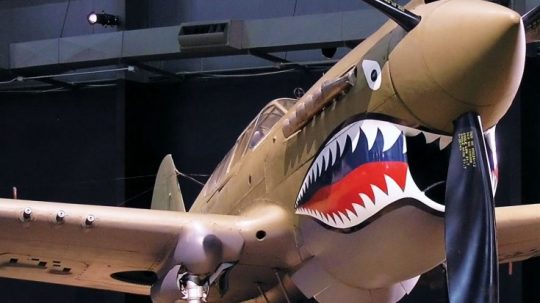#RAF history
Explore tagged Tumblr posts
Text
Such glorious photo of HM King George VI visiting No. 617 Squadron in 1943.

#King George VI#1943#No. 617 Squadron#Royal visit#WWII history#RAF history#British royalty#Military history#World War II#Bomber Command#Dambusters#Wartime Britain#Historic moment#Royal Air Force#British monarchy#Wartime visit#Leadership#King in uniform#British heritage#Allied forces#today on tumblr
27 notes
·
View notes
Text

The last of “The Few” turns 105.
Group Captain John “Paddy” Hemingway DFC, AE, is the last verified surviving pilot of the Battle of Britain. He was born in Dublin on 17 July 1919.
He served during the Second World War in the Battle of Dunkirk, the Battle of Britain, the Allied invasion of Italy and the Invasion of Normandy. Following the death of Terry Clark in May 2020, Hemingway became the last verified surviving airman of the Battle of Britain. He was shot down four times during the Second World War.
Per Ardua ad Astra - "Through Adversity to the Stars"
2K notes
·
View notes
Text
RAF Service Part 3 - HQ324 Wing September 1946 (updated)
According to my grandfather's RAF military record, after his posting in Naples he was then relocated to HQ324 Wing. This was located at Tissano in the Friuli-Venezia Giulia region of North Italy, approximately 7 hours drive.

Further detail following second visit to National Archives
Relocation of approximately 650 personnel (including my grandfather) took place through September and October 1946.

However, despite the effective relocation, things were not great at the new camp. During an assessment undertaken by the Senior Medical Officer, the camp was "unsuitable for any RAF units". Sanitation, hygiene and the cookhouses were all noted as "poor" and they were sleeping under canvases. Ambulances were in "constant trouble" and communications were also "very poor" and no messages could be transmitted to HQ.
From November, the unit was relocated 5 miles away to Pozzuolo, but things were only slightly better here. Conditions were still described as "sheer squalor". Personnel were still in over-crowded caravans, unable to bathe, whilst the weather was "extraordinarily severe" making it a "frozen, inhospitable camp area".
To cope with the poor living situation, and whilst renovations were taking place, certain activities were moved to more suitable places. The canteen was set up in "a large building in the village of Pozzuolo" and "cinema facilities..to Udine nightly" (cinema playing a critical role for both relaying information and raising morale). "Liberty runs" were also started nightly in Treviso in early 1947, along with "Venice on Saturdays". Then this delightful bit of detail is recorded:

My grandfather was "other rank"! And the Eden Bar in Treviso only closed its doors recently. (Also of interest here is that plans were only just being made to extend cinema visits to other (lower) ranks. I imagine officers were granted this privelege first).
Treviso however is over 70 miles from Pozzuolo. Nightly runs would have been a significant committment. Maybe some sort of deal was struck with Treviso to allow for a large number of allied forces to let their hair down in their town? Was it deemed safer or more secure than somewhere closer like Udine? This seems surprising given the heavy bombing of Treviso undertaken by Allied forces a few years previously.
I've checked old photos of my grandfather during this time. As I have posted before, we have dozens of photos in our collection, each a crumb in the trail, a piece of the jigsaw.
This photo looks like it may have been taken in either Tissano or Pozzuolo, the architecture being fairly similar.

Unsurprisingly I couldn't identify the exact location, but the windows look similar in style to these tiny villages. I am going to make a tiny leap and say that this was taken during his time in Pozzuolo between November 1946 and June 1947.
From documents obtained from the National Archives in Kew they were still undertaking various exercises, including bombing training, ground weapon training, parachute and crash drills.

As I have mentioned a number of times before, I am no military historian, but I am curious as to why these exercises where still being run after the war had ended. Was it in case a threat re-emerged? Was it for fear of Russia and communism as the cold war loomed? And do I have to start researching the Cold War now 😭?
I really wish I could have had the opportunity to speak with my grandfather about how he felt at this time, torn between his homeland in Yugoslavia and his possible new life in the West.
0 notes
Text

God someone please help them they’re lost
#this has been in my wips for probably over a year and I’m tired of looking at it#I already tried to recolour it and redo some of the lines and I’m still :/#maybe I’ll do a redraw someday#anyway twink RAF#what’re they even looking for#painting them on the side of my plane fr#my art#wwii#illustration#vintage gay#pinup art#raf#lgbtq history
506 notes
·
View notes
Text

An RAF Supermarine Walrus seaplane comes to the aid of a downed pilot - English Channel 1943
#world war two#ww2#worldwar2photos#history#1940s#ww2 history#wwii#world war 2#ww2history#wwii era#royal air force#1943#raf#supermarine#walrus#seaplane#rescue#english channel#channel#Atlantic#pilot
182 notes
·
View notes
Text

The RAF had a sense of style. :)
280 notes
·
View notes
Text

A Catalina Mk II of No 240 Squadron based at Stranraer, Scotland, March 1941
244 notes
·
View notes
Text

Lightning strikes. Illustration detail from a Lockheed Aircraft Corporation ad - 1942.
#vintage illustration#vintage advertising#lockheed aircraft corporation#ww2#wwii#ww2 era#wwii era#ww2 history#wwii history#u.s. military#military aircraft#lockheed lightning#interceptor aircraft#vintage aircraft#vintage airplane#life during wartime#interceptor planes#the 40s#the 1940s#lockheed#lockheed p-38 lightning#p 38 lightning#p-38 lightning#p-38#p 38#raf#royal air force
44 notes
·
View notes
Video
1953 Armstrong Whitworth Gloster Meteor F-8 No.56 RAF Squadron WK991 by Chris Murkin Via Flickr: 1953 Armstrong Whitworth Gloster Meteor F-8 No.56 RAF Squadron WK991 Photos taken at the Imperial War Museum Duxford Cambridgeshire 20th March 2025 YYB_2145
#Armstrong#Whitworth#Gloster#Meteor#F-8#RAF#WK991#No.56#Squadron#Show#AIRCRAFT#AEROPLANE#Aviation#Warbird#WWII#Photo#PLANE#Nikon#Display#War#Museum#Duxford#History#Vintage#Image#Warbirds#Airshows#Photographic#Photography#JET
35 notes
·
View notes
Text

RAF De Havilland Mosquito IVs 105 Squadron, Marhamn on December 1942.
➤➤ VIDEO: https://youtu.be/yoNk0Ky3lH4
#de havilland#Mosquito#De Havilland Mosquito#britain ww2#youtube#aircraft#airplane#aviation#dronescapes#military#documentary#aviation history#ww2#wwii#britain#military aviation#wwii bomber#RAF#Colorized#1942#circa 1942
151 notes
·
View notes
Text

Royal Air Force - Eurofighter Typhoon
#military#aircraft#air force#fighter jet#aviation#fighter plane#plane#raf#royal air force#eurofighter#eurofighter typhoon#aviation photography#aviation history#military aviation#phtography
89 notes
·
View notes
Text

P-40’s Shark Teeth Didn’t Originate From The Flying Tigers...Here’s the story....

The AVG Flying Tigers got the idea after seeing a newspaper picture of a P-40 from the No. 112 Squadron of the Royal Air Force. Fighting in Egypt, Sudan, Greece and Crete, they were one of the first squadrons to fly the P-40 and painted them with the shark mouth because they thought the intake looked perfect for it. That’s why they were nicknamed the “Shark Squadron.” Although the idea was theirs to paint the Warhawk, the graphic was not.....

The first documented use of the Shark Teeth nose art was by the Zerstörergeschwader 76 group of the Luftwaffe. Formed in 1939, they flew Bf 110Cs and it was them who were first seen painting their noses with the iconic shark teeth logo. They didn’t have the eyes on them as that was added by the RAF, but the shark mouth appears to be their original idea.
#Nose art#shark mouth#shark teeth#P-40#Warhawk#Aviation history#RAF#AVG#Luftwaffe#nose art history#Bf 110
163 notes
·
View notes
Text

A flypast has honoured the bravery of Britain's last surviving Victoria Cross holder for air action in World War Two, who is now aged 104.
Flight Lieutenant John Cruickshank earned the honour aged 24 for an attack on a German U-boat while piloting a Catalina flying boat.
Despite being badly injured, the pilot and his crew managed to sink the submarine.

A Catalina flew over where he lives in Aberdeen, marking 80 years since he was awarded the Victoria Cross.
It is the highest recognition for valour that can be awarded to members of the British and Commonwealth Armed Forces.

92 notes
·
View notes
Text



Backstory of the R. A. F. rug
#lawrence of arabia#t e lawrence#t. e. lawrence#history#t e shaw#t.e. lawrence#source: the golden reign#clare sydney smith#sydney smith#r. a. f.#raf#clouds hill#cottage
50 notes
·
View notes
Text




Stirling Bomber War Memorial.
Installed in October 2015 at Tockwith, North Yorkshire, England.
The bomber was about to land on the nearby Marston Moor Airfield when it crashed in the main street killing the village postmaster, all six crew members and wrecking 19 houses.
#Monument#Sculpture#Statue#War Memorial#History#Heritage#Aesthetic#Photography#Wanderlust#Explore#Military#Aircraft#Aviation#WW2#RAF#Plane#Airplane#British#Bomber#UK
56 notes
·
View notes
Text

A German sentry on guard at RAF headquarters in Jersey during its occupation - Channel Islands 1940-1945
#world war two#ww2#worldwar2photos#history#1940s#ww2 history#wwii#world war 2#ww2history#wwii era#channel islands#jersey#occupation#sentry#raf#royal air force#headquarters
173 notes
·
View notes
